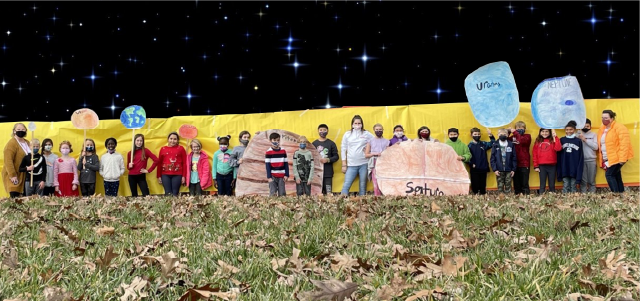 At
Piney
Branch
Elementary
School,
students
in
Elizabeth
McKeown's
fourth-grade
class
were
excited
to
"toilet
paper
or
TP"
the
school
lawn
all
in
the
name
of
science.
Students
conducted
a
performance-based
lesson
on
the
solar
system,
which
is
part
of
the
fourth-grade
science
curriculum.
Students
demonstrated
the
distance
between
planets
and
the
sun
using
toilet
paper
squares
as
the
unit
of
measurement,
and
the
school's
fence
as
a
metaphor
for
the
sun.
Students
placed
squares
of
toilet
paper
from
the
fence
to
the
scale
models
they
built
for
Mercury,
Venus,
Earth,
Mars,
Jupiter,
Saturn,
Uranus,
and
Neptune.
Students
were
divided
into
groups
and
used
calculations
they
derived
in
their
classroom
to
see
how
many
squares
to
use.
The
students
assigned
to
Mercury
used
about
four
squares
from
the
fence,
while
the
students
assigned
to
Neptune
unrolled
almost
a
full
roll
of
toilet
paper
to
represent
its
vast
distance
from
the
sun.
At
Piney
Branch
Elementary
School,
students
in
Elizabeth
McKeown's
fourth-grade
class
were
excited
to
"toilet
paper
or
TP"
the
school
lawn
all
in
the
name
of
science.
Students
conducted
a
performance-based
lesson
on
the
solar
system,
which
is
part
of
the
fourth-grade
science
curriculum.
Students
demonstrated
the
distance
between
planets
and
the
sun
using
toilet
paper
squares
as
the
unit
of
measurement,
and
the
school's
fence
as
a
metaphor
for
the
sun.
Students
placed
squares
of
toilet
paper
from
the
fence
to
the
scale
models
they
built
for
Mercury,
Venus,
Earth,
Mars,
Jupiter,
Saturn,
Uranus,
and
Neptune.
Students
were
divided
into
groups
and
used
calculations
they
derived
in
their
classroom
to
see
how
many
squares
to
use.
The
students
assigned
to
Mercury
used
about
four
squares
from
the
fence,
while
the
students
assigned
to
Neptune
unrolled
almost
a
full
roll
of
toilet
paper
to
represent
its
vast
distance
from
the
sun.Fourth-grade student Jackson Anders shared, "I thought it was really fun. It helped me learn how to tell the distance between the planets and the sun. It was also a fun way to learn." Another student, Juliet Curcio, added, "I thought this project was fun. Because, well come on, it's SPACE! It involved a lot of toilet paper though."
Performance-based learning allows students to guide their learning journey by participating in intentional and engaging activities directed to further their understanding of a subject. This outdoor assignment was a culmination of language arts, mathematics, and science lessons the students had learned inside the classroom. Students also wrote a report on their planet following the writing process: research, writing a rough draft, revision and peer review, and final draft. To reinforce their understanding, each student group presented facts about their planet to the rest of the class.
This lesson was co-taught with Kristine Klink, special education teacher, and Adrienne Nguyen, English language learner (ELL) teacher, so students with different learning needs could learn and grow from each other in a supportive environment.
Nguyen shared that this co-taught lesson follows the school's mission to, "surpass the status quo with innovation that engages students."
"This planned activity is a creative approach to learning about the solar system. It allows the students to demonstrate what they are learning other than standard pencil and paper," McKeown said.
